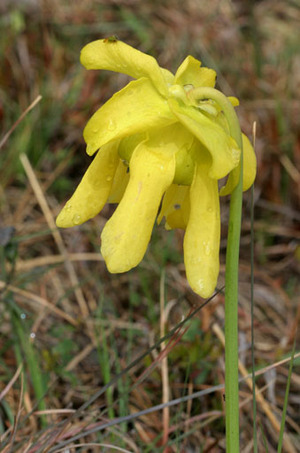When people think of carnivorous plants, Venus fly traps and pitcher plants are usually the first thing to come to mind. However, the most ingeniously designed carnivorous plants in the world live in aquatic habitats and operate by a whole different set of rules. Let’s dive into the waters of aquatic carnivorous plants and learn about two of these creatures: the bladderwort and the waterwheel plant. We’ll also take a brief look into the question of carnivorous plants in the world’s oceans.
Bladderworts
Bladderworts are amongst the most widespread of the carnivorous plants with well over 200 species that have a cumulative range covering much of the earth. Bladderworts can be either aquatic, semi-aquatic or terrestrial. Species of this plant that live on the water stay afloat by a set of ingeniously designed bladders that are both flotation devices and a food source. These pod-like bladders grow on stems branching symmetrically from the base of the plant with a vacuum seal that keeps out water and holds pockets of air to keep the plant afloat. However, these seals are designed with a mechanical trapping mechanism at the end of beak shaped structure that lures prey to the mouth of the bladder. As soon as the prey has violated the seal of the bladder, the mouth springs open, allow in a brief gush of water that washes the prey inside. Digestive enzymes then break down the prey and the nutrients are absorbed into the plant. Meanwhile, the water is pumped back out of the bladder, and the mechanism is soon ready for it’s next meal.
Waterwheel Plant
The exceedingly rare waterwheel plant, or Aldrovanda, is an equally fascinating plant. Much like the Venus fly trap, the waterwheel feeds with the use of a snap trap that catches insects in its jaws, digests them, absorbs the needed nutrients and opens up for whoever is next. According to the International Carnivorous Plant Society, it was Charles Darwin who first discovered that this plant was truly carnivorous, with prey to include insects and small crustaceans . Interestingly, the waterwheel has no root structure but floats about freely on the surface of the water catching prey as it goes. The plant propagates with a small, unassuming flower that are fertilized above water, while the fruit actually grows beneath the water. Waterwheels are only found in limited pockets of Europe, Asia, Australia, and Africa. Although that is a wide range, the plants are only sparsely distributed along avian routes of the birds that spread their seeds.
Carnivorous Plants at Sea?
Carnivorous plants are vascular plants, meaning they transport sugar through one organ, the phloem, and water and salts through another, the xylem. Vascular plants have a great deal of difficulty living in marine environments due to the high content of salt. At this time, there are no known carnivorous plants that can live in a marine environment, but the ocean is full of surprises and undiscovered life forms.
Sources:
http://www.sarracenia.com/faq/faq7510n.html
http://en.wikipedia.org/wiki/Bladderwort#Trapping_mechanism
http://www.ppws.vt.edu/scott/weed_id/utrspp.htm
http://www.ecy.wa.gov/programs/wq/plants/weeds/bladder.html
http://www.sarracenia.com/faq/faq5040.html
http://www.threatenedspecies.environment.nsw.gov.au/tsprofile/profile.aspx?id=10035
http://en.wikipedia.org/wiki/Waterwheel_plant#Flowers



